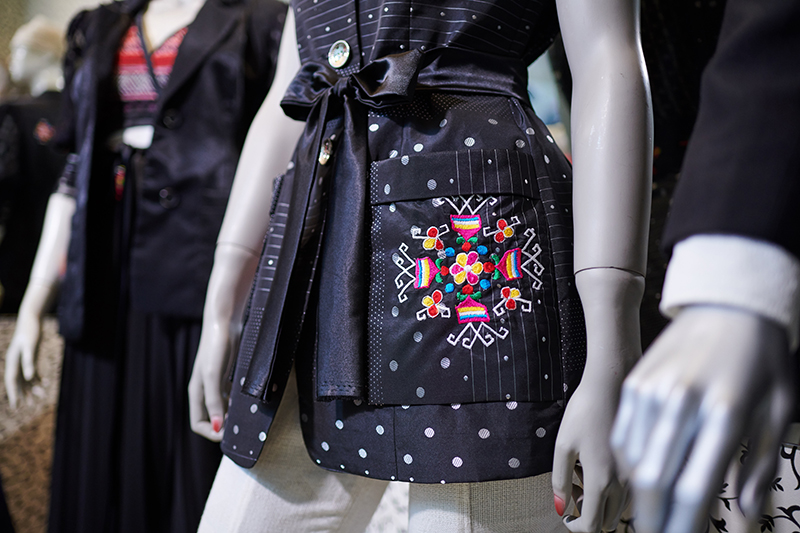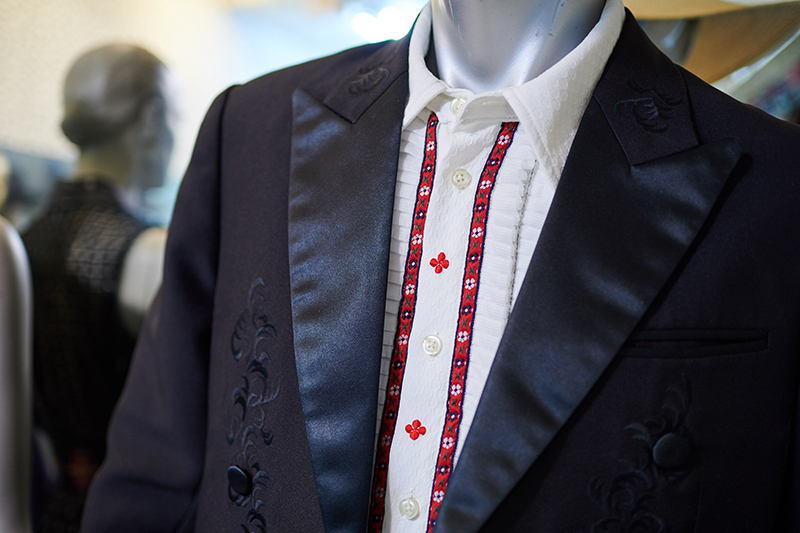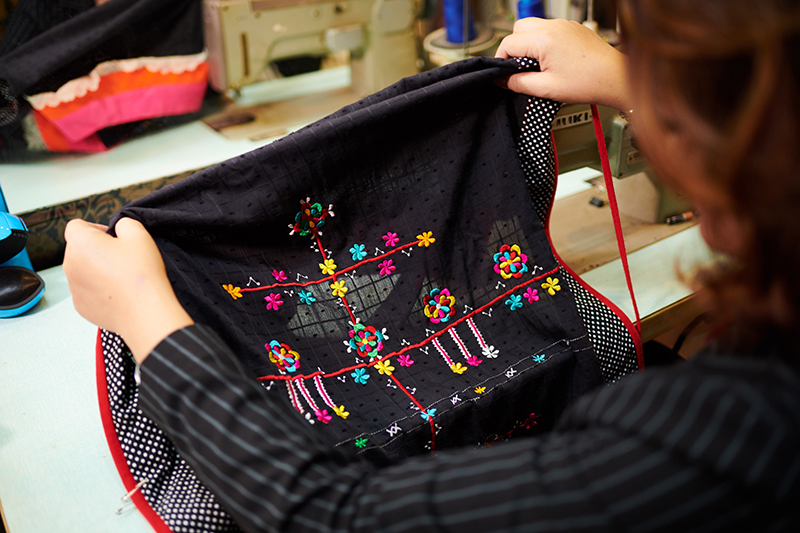Above: Tefi Takano designs clothes that are trendy and fused with the cultural elements of the Pangcah people, taking clothing to a whole new level.
Tefi Takano draws infinite inspirations of colors from the lush green kalotungang (Mt. Kingkong), the blue Pacific Ocean, and the coastal rice terrace lining between the mountains and the ocean. One professional model after another strut down the catwalk in front of the Dongli Train Station during the autumn harvest season, with the golden waves of rice in Yuli Township, Hualien County as backdrop. Among which, themed “Love of the Ocean and Mountain”, Pangcah fashion designer Tefi Takano combined Pangcah embroidery patterns with modern clothing, demonstrating a novel grace that captured the attention of many.
Tefi Takano, dressing the professional models in clothes designed by her, stood out amongst all designers in the Yu Fu Fashion Show three years in a row, and qualified for the TOTEM Fashion Show hosted by Taiwan Textile Federation for eleven consecutive years. Even A-Lin, the famous indigenous singer, and Kolas Yotaka, spokesperson for the Executive Yuan, requested her for their tailor-made outfits.
Practicing Since Childhood
Mother as Her Mentor
Tefi Takano grew up in Kakacawan (Changbin township), Taitung County, where elders in the family present their coming-of-age children with a full set of hand-sewn traditional indigenous gown, symbolizing their independence. However, as devoted Christians, no one in her family wore traditional indigenous clothing anymore, and the earliest gowns she came to know were instead glamorous modern couture.
“Mother once made lace-embroidered dresses for my older sister and I, and they were gorgeous.” Tefi Takano's mother was the master tailor in the village, and her aunt owned a tailor studio providing bespoke tailoring for people in the Kakacawan village. As Tefi recalls, whenever her mother found the time between house chores and farming, she would huddle in front of the sewing machine, working her magic to make beautiful clothes. Back then, almost everyone in the village would ask her mother and her aunt to make them glamorous new clothes for important events, festivals and ceremonies, be it a kimono, dress or suit. The mixture of indigenous and non-indigenous cultures was common, with people dressed in either traditional indigenous gowns or modern clothes for important events in the village.
Influenced since young age, Tefi Takano learnt early the skills of sewing, and started making clothes for people beginning junior high. The various styles of clothes were also ingrained in her that they all became inspirations she drew on later in life.
Strict Training in the Fashion Industry
Paved for Her Debut in the TOTEM Fashion Show
Upon graduation, Tefi Takano left for Taipei and worked as a template maker in the fashion industry for 10 years. She said that the pattern maker, designer and sample maker form the holy trinity in a clothing company. The pattern maker turns sketch design into cardboard patterns, the template maker on the other hand needs to discuss repeatedly with the designer to turn the image the designer had in mind into tangible clothes. It was very hard work, but Tefi Takano, the forever optimist, was very happy. She considered herself lucky to have met a teacher who was willing to teach her everything, “it's usually the details that determine the success or failure, even the ironing has its tricks.” To this day, Tefi Takano is grateful that her teacher taught her everything there is to know.
Two decades ago, with the designing and tailoring skills and experiences under her belt, Tefi Takano finally established her very own Tefi Indigenous Studio, and made her debut in the first ever TOTEM Fashion Show. When asked why she wanted to merge elements of indigenous cultures with modern clothing, Tefi Takano said that traditional indigenous apparels are often worn in rituals and ceremonies, glamorous but too heavy for the busy modern society. With a little modification combined with simplified tailoring, the meaningful traditional elements can also thrive in everyday life.



The traditional clothes of the Pangcah people is colorful and bright, adding the perfect touch to the sleek modern clothing. With simple cuttings, patterns accentuate the quality.
Discover stories in the Villages
Cherish the Trust of Every Elder
For more inspirations, Tefi Takano often returns to her home village on the east coast, learn from the elders stories behind the traditional gowns, and ask very carefully whether certain patterns may be used for recreation. There are many varieties to the Pangcah embroidery patterns and rainbow colors, Tefi Takano explains. People in the Kakacawan village used to live on fishing, so fishes in the ocean became patterns embroidered on their clothing; the diamond pattern symbolizing the ancestors' eyes, on the other hand, is not found in the Kakacawan village.
As a fashion designer, Tefi Takano has great admiration for the Atayal people who excel at weaving. The Pangcah people began trading with the nonindigenous people since the early days, she said, and lost the art of weaving very early on, but the Atayal people retained the craft really well. In the early days, they mainly used sisal and banana fiber as filament, and produced stripes with small diamond patterns with on-floor loom, the patterns record in detail the stories of their villages and families. An old Atayal lady once gave Tefi Takano a woven band she treasured, and asked for it to be made into beautiful clothing. Unfortunately, when Tefi Takano finally made it into a gorgeous coat and brought it back to the village, the old lady had already passed away.
Tefi Takano believes that proper field research is her way of respecting indigenous cultures. Being an optimist, she never really encountered any setbacks in fashion design. But what really upsets her is when she sees how contemporary fashion designers tend to carelessly copy ethnic clothes from other countries and produce what they call “traditional clothing for Taiwan indigenous peoples”. Not only are they nothing alike, but they undermine the format and traits of traditional indigenous clothing, which really makes Tefi Takano sad.


Growing up intimately connected to sewing, Tefi Takano is trained with excellent tailoring skills.
Learn from Foreign Experiences
Turn Culture into Fashion with Practicality
“My clothes are all about the tailoring. 40% of the design elements come from indigenous cultures, and the rest are in line with fashion trend.” Tefi Takano does not design clothing series for a specific group of people, because each piece is unique. She visits her clients to understand the use of the tailored clothes, at what event and in what season will the clothes be worn, before she tailor the clothes to their request.
Many indigenous people choose to wear modernized indigenous clothing at weddings, and ask Tefi Takano to design clothes for the entire family, everyone from the bride and groom to the best man, maid of honor and officiator are all placed in her hands. She points out that unless clients insist, she tends to tone down her design without following blindly the trend, because she wants her clients to feel comfortable wearing the clothes she made in everyday life as well.
Elements of fashion are always changing, Tefi Takano flies overseas for fashion shows from time to time and flip through many foreign fashion magazines to keep up with the trend. She believes that innovation is possible in traditional indigenous cultures as well, and she always think outside the box. Over the years, she has had many overseas clients who fell in love with her design during fashion shows and placed orders directly during the show. Her long-time patrons include wives of European diplomats and geishas from Japan. Ethnic styles have always been a favored element in the fashion world, Tefi Takano said, and often used by designer brands as well. She hopes that her works can take off internationally as well.
In 2019, Tefi Takano brought her 92-year-old aunt to see the fashion show in Taitung. When her aunt saw models walk down the catwalk with bamboo baskets she made on their backs and dressed in clothes designed by Tefi Takano, her eyes welled up. Having witnessed the little girl in her studio learning how to sew, and seeing her now as an independent and well-established fashion designer, filled with affection, her aunt said, “well done, I will tell your mother all about it when I meet her on the other end of the rainbow bridge.”
Those words from her aunt were the best recognition Tefi Takano received ever. Inheriting the exceptional skills of her mother, tailoring clothes that are exquisite beyond words, her confidence towards her culture lend extra pride to the indigenous peoples wearing them in the modern world.

Tefi Takano digs into the history of indigenous patterns and checks repeatedly with elders in indigenous villages when combining the design with other patterns, just to avoid abusing the cherished culture.




